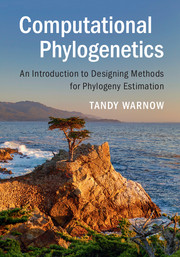Book contents
- Frontmatter
- Dedication
- Contents
- Preface
- Glossary
- Notation
- PART I BASIC TECHNIQUES
- PART II MOLECULAR PHYLOGENETICS
- 8 Statistical Gene Tree Estimation Methods
- 9 Multiple Sequence Alignment
- 10 Phylogenomics: Constructing Species Phylogenies from Multi-Locus Data
- 11 Designing Methods for Large-Scale Phylogeny Estimation
- Appendix A Primer on Biological Data and Evolution
- Appendix B Algorithm Design and Analysis
- Appendix C Guidelines forWriting Papers About Computational Methods
- Appendix D Projects
- References
- Index
8 - Statistical Gene Tree Estimation Methods
from PART II - MOLECULAR PHYLOGENETICS
Published online by Cambridge University Press: 26 October 2017
- Frontmatter
- Dedication
- Contents
- Preface
- Glossary
- Notation
- PART I BASIC TECHNIQUES
- PART II MOLECULAR PHYLOGENETICS
- 8 Statistical Gene Tree Estimation Methods
- 9 Multiple Sequence Alignment
- 10 Phylogenomics: Constructing Species Phylogenies from Multi-Locus Data
- 11 Designing Methods for Large-Scale Phylogeny Estimation
- Appendix A Primer on Biological Data and Evolution
- Appendix B Algorithm Design and Analysis
- Appendix C Guidelines forWriting Papers About Computational Methods
- Appendix D Projects
- References
- Index
Summary
Introduction to Statistical Estimation in Phylogenetics
Phylogeny estimation from biomolecular sequences is often posed as a statistical inference problem where the sequences evolve down a tree via a stochastic process. Statistical estimation methods take advantage of what is known (or hypothesized) about that stochastic process in order to produce an estimate of the evolutionary history. When we consider phylogeny reconstruction methods as statistical estimation methods, many statistical performance issues arise. For example: Is the method guaranteed to construct the true tree (with high probability) if there are enough data (i.e., is the method statistically consistent under the model)? How much data does the method need to obtain the true tree with high probability (i.e., what is the sample complexity of the method)? Is the method still relatively accurate if the assumptions of the model do not apply to the data that are used to estimate the tree (i.e., is the method robust to model misspecification)?
Markov models of evolution form the basis of most computational methods of analysis used in phylogenetics. The simplest of these models are for characters with two states, reflecting the presence or absence of a trait. However, the most common models are for nucleotide (four-state characters) or amino acid (20-state characters) data. They can also be used (although less commonly) for codon data, in which case they have 64 states (Goldman and Yang, 1994; Yang et al., 2000; Kosiol et al., 2007; Anisimova and Kosiol, 2009; De Maio et al., 2013).
In Chapter 1, we described the Cavender–Farris–Neyman (CFN) model of binary sequence evolution, and a simple method to estimate the CFN tree from binary sequences. In this chapter we focus on sequence evolution models that are applicable to molecular sequence evolution. As we will see, the mathematical theorems and algorithmic approaches are very similar to those developed for phylogeny estimation under the CFN model.
Statistical identifiability is an important concept related toMarkov models.We say that a parameter (such as the tree topology) of the Markov model is identifiable if the probability distribution of the patterns of states at the leaves of the tree are always different for two Markov models that are different for that parameter. Thus, some parameters of a model may be identifiable while others may not be. For example, the unrooted tree topology is identifiable under the CFN model, but the location of the root is not.
- Type
- Chapter
- Information
- Computational PhylogeneticsAn Introduction to Designing Methods for Phylogeny Estimation, pp. 145 - 177Publisher: Cambridge University PressPrint publication year: 2017



